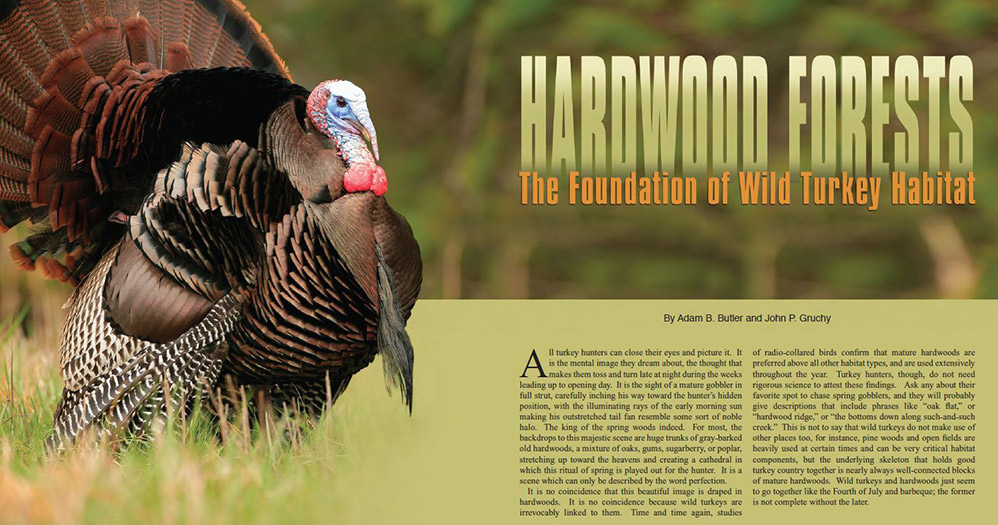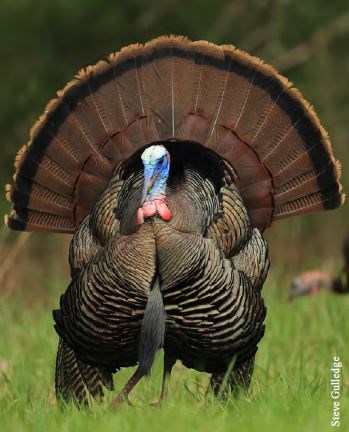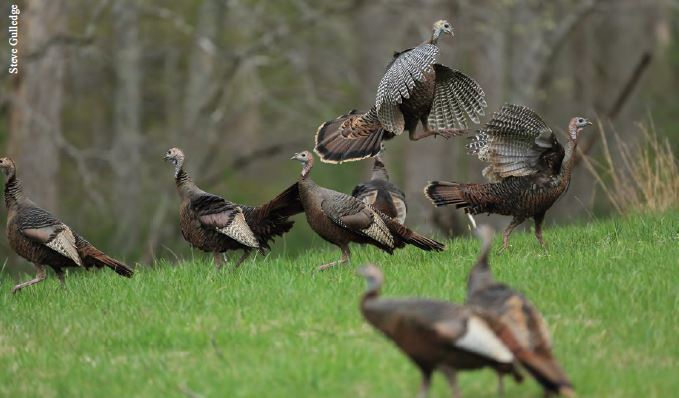Hardwood Forests: The Foundation of Wild Turkey Habitat
2/28/2018 10:11:05 AM
From MDWFP

All turkey hunters can close their eyes and picture it. It is the mental image they dream about, the thought that makes them toss and turn late at night during the weeks leading up to opening day. It is the sight of a mature gobbler in full strut, carefully inching his way toward the hunter’s hidden position, with the illuminating rays of the early morning sun making his outstretched tail fan resemble some sort of noble halo. The king of the spring woods indeed. For most, the backdrops to this majestic scene are huge trunks of gray-barked old hardwoods, a mixture of oaks, gums, sugarberry, or poplar, stretching up toward the heavens and creating a cathedral in which this ritual of spring is played out for the hunter. It is a scene which can only be described by the word perfection.
It is no coincidence that this beautiful image is draped in hardwoods. It is no coincidence because wild turkeys are irrevocably linked to them. Time and time again, studies of radio-collared birds confirm that mature hardwoods are preferred above all other habitat types, and are used extensively throughout the year. Turkey hunters, though, do not need rigorous science to attest these findings. Ask any about their favorite spot to chase spring gobblers, and they will probably give descriptions that include phrases like “oak flat,” or “hardwood ridge,” or “the bottoms down along such-and-such creek.” This is not to say that wild turkeys do not make use of other places too, for instance, pine woods and open fields are heavily used at certain times and can be very critical habitat components, but the underlying skeleton that holds good turkey country together is nearly always well-connected blocks of mature hardwoods. Wild turkeys and hardwoods just seem to go together like the Fourth of July and barbeque; the former is not complete without the later.
Bounty in the Big Woods
 The significance of hardwoods to wild turkeys is many and varied. Their most evident appeal is the food resources they provide. Forests with a significant oak component yield a tremendous quantity of acorns throughout the fall, winter, and early spring. Less noticeable, but just as important, is the mast provided by non-oak hardwoods. American beech is relished by turkeys, although only sporadically available. Pecan can also be critical hard mast, particularly along the Mississippi River. Likewise, the fruits and soft mast produced by various other native trees, shrubs, and vines associated with hardwood forests are important to turkeys because many are available at times when hard mast is not. Black cherry, red mulberry, dogwood, sugarberry, black tupelo, hollies, wild grapes, and many others are included in this group. Even the light-weight, wind-blown seeds, or samaras, of some hardwood trees like ironwood and red maple, can be heavily utilized at certain times.
The significance of hardwoods to wild turkeys is many and varied. Their most evident appeal is the food resources they provide. Forests with a significant oak component yield a tremendous quantity of acorns throughout the fall, winter, and early spring. Less noticeable, but just as important, is the mast provided by non-oak hardwoods. American beech is relished by turkeys, although only sporadically available. Pecan can also be critical hard mast, particularly along the Mississippi River. Likewise, the fruits and soft mast produced by various other native trees, shrubs, and vines associated with hardwood forests are important to turkeys because many are available at times when hard mast is not. Black cherry, red mulberry, dogwood, sugarberry, black tupelo, hollies, wild grapes, and many others are included in this group. Even the light-weight, wind-blown seeds, or samaras, of some hardwood trees like ironwood and red maple, can be heavily utilized at certain times.
Hardwood forests also hold much more subtle and complex foods. The layer of leaves, or duff, on the forest floor beneath the canopies of deciduous trees, is literally crawling with tremendous assortments of insects, arachnids, worms, and other creatures that are hard at work breaking down the duff and other detritus. These soft-bodied critters are a source of protein that is critical for egg development in nesting hens and feather development and growth in young poults. In bottomland hardwoods, low-lying wet areas contain snails, crayfish, and other crustaceans that the birds frequently feed upon. With all the food items that wild turkeys can scratch up, it is no wonder that mature hardwoods are so heavily used!
Cornerstone of the Landscape
Cutting-edge collaborative research between the Mississippi Department of Wildlife, Fisheries, and Parks (MDWFP) and Mississippi State University (MSU), is attempting to quantify just how important the distribution of different forest types, including hardwoods, are for turkeys across expansive landscapes. Annie Davis, a graduate student under the direction of Dr. Guiming Wang at MSU’s College of Forest Resources, has combined harvest data from MDWFP Wildlife Management Areas (WMAs) with landscape measurements around those areas to investigate the influence broad-scale habitat variations have on turkey abundance. Her findings suggest that while complex landscapes, those with a variety of different forest types, openings, and other land covers evenly intermingled, are the most beneficial at large spatial scales, the hardwood component of this mix is the key determinant of turkey abundance throughout the overall area. Comparisons of the land cover around 28 different WMAs reveal that the proportion of the landscape composed of hardwood forests strongly influences turkey harvest potential, and while only one-quarter to one-third of the landscape needs to be mature hardwoods, an inadequate amount of this cover type can be a limiting factor. From this research, a set of general guidelines is being developed to help paint a picture of the ideal landscape for wild turkey management.
Timbering for Turkeys
Even though turkey hunting experience and modern science both confirm the benefits of maintaining adequate amounts of hardwoods for turkeys, this does not infer that active timber management has no place in these forests when the birds are a concern. To the contrary, thoughtfully implementing timber harvests or other stand improvement practices can increase long-term value for both wild turkeys and landowner’s wallets. The keys are to acknowledge the context of the landscape surrounding a given hardwood stand and then recognize the tradeoffs that might come as a result of altering the stand’s composition and structure. These insights can only be gained through careful planning.
The development of a management plan should always be the first step in managing any forest. In most cases, management plans are the result of compromises between multiple objectives, such as incurring timber revenue while maintaining suitable habitat for turkeys. A good plan should adequately address multiple objectives without fully giving way to one or the other. The most important part of developing a forest management plan is clearly stating the objectives of management actions, and prioritizing those objectives based on the overarching goals of forest ownership. While the management practices necessary to meet individual objectives may change over the life of a five or ten-year planning horizon, the goals of ownership should remain constant.
Once the goals of ownership have been clearly defined, the next step is an evaluation of existing stand characteristics. Defining the physical character of the site is very important when dealing with hardwoods. Site characteristics include location, physiographic region (delta, bluff hills, coastal plain, etc.), topography, soil types, site index (a measurement of estimated height growth in 50 years), and drainage class. Important forest characteristics include tree species composition, product class (pulpwood, saw logs, etc.), stocking (number of stems per acre), as well as several others. Wild turkey enthusiasts should also note areas that seem to receive excessive turkey use at different seasons and the availability of habitats both within each stand and throughout the property that meet specific life-cycle needs.

Where wild turkeys are a concern, an important consideration is the balance between the open conditions provided by older hardwood stands, which are preferred by adult birds most of the year, and the thicker, brushy cover that’s a necessity for producing and raising the young. Due to shorter rotations and other available management practices, nesting cover is rarely lacking in pine-dominated landscapes. As such, maintaining open understory conditions within hardwoods stands may be more applicable in meeting wild turkey’s overall habitat needs in these more diverse landscapes than areas along the bluff hills or major river drainages where large swaths of the predominant hardwood cover type can be void of thicker early successional cover. In those settings, timber harvests may be the most effective means of promoting nesting and brooding habitat and are an important component of wild turkey management.
In most cases, hardwood stands should not be cleared and converted to other land uses where turkeys are a management objective. When hardwood harvests do become a necessity, care should be taken to leave a residual stocking of dominant and codominant trees of a variety of species and size classes, while simultaneously opening the forest canopy enough to stimulate understory plant communities. Natural oak regeneration should generally be a core consideration and will require timing harvests to maximize opportunities to capture seedling germination, with later follow-up cuts to release young saplings.
Hardwoods are inarguably a key ingredient of good turkey country. Efforts to maximize turkey abundance hinge upon ensuring adequate proportions of hardwoods across large landscapes, and wisely managing existing hardwood stands to enhance, rather than degrade, their value to the birds. With these cardinal rules of wild turkey conservation in mind, hunters and landowners can ensure that populations have been given all they need in order to thrive and that the king of spring will always have a place to call his home.
Adam Butler is a Turkey Program Biologist for the MDWFP John Gruchy is the Private Lands Program Coordinator at MDWFP.









